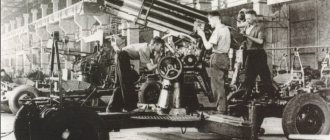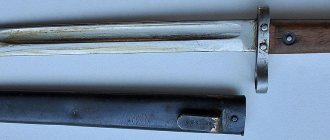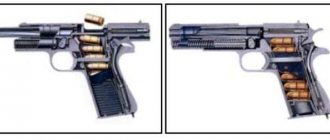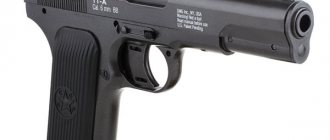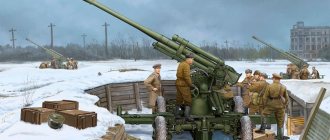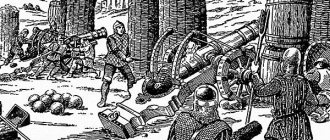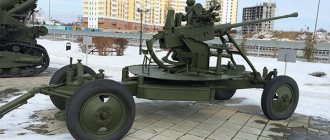A gun
Field gun type
| 107 mm divisional gun M1940 (M-60) | |
| M-60 in the Artillery Museum, St. Petersburg | |
| Type | field gun |
| Place of origin | USSR |
| Service history | |
| Used | USSR |
| Wars | The Second World War |
| Production history | |
| Designer | Plant No. 172, Petrov F.F. |
| Developed | 1938-1940 |
| Manufacturer | Plant No. 172, Plant No. 352 |
| Produced | 1940-1941 |
| No built | 139 |
| Characteristics | |
| Weight | Combat: 4,000 kg (8,818 lb) Travel: 4,300 kg (9,480 lb) |
| Length | 8.09 m (26 ft 7 in) |
| Barrel length | Bore: 4.47 m (14 ft 8 in) L/41.8 Overall: 4.6 m (15 ft 1 in) L/43 |
| Width | 2.20 m (7 ft 3 in) |
| Height | 1.92 m (6 ft 4 in) |
| Crew | 8 |
| Caliber | 106.7 mm (4.21 in) |
| Breech | broken screw |
| Shipping | Divided Path |
| Height | -4.5° to 45° |
| Traverse | 60 ° |
| Rate of fire | 6-7 rounds per minute |
107-mm divisional gun model 1940 (M-60)
(
Russian: 107-mm divisional gun model 1940 (M-60)
) was a Soviet artillery weapon developed in the late 1930s to provide Soviet divisional artillery with a powerful field and anti-tank rifle. The weapon entered production in 1940, but production ceased shortly after the outbreak of the Soviet-German War; Only a limited number were built. These guns served in the Red Army during the war.
Development[edit]
Background [edit]
Until the late 1930s, Soviet divisional artillery consisted of 76.2 mm guns, designed to use the same 1900-pattern cartridge case, supplemented by 122 mm howitzers. The reason for the continued dependence on the 76.2 mm was that the USSR had large stocks of 76.2 mm ammunition, some of which had been supplied during World War I, and also had suitable production equipment. Various improvements in metallurgy, chemistry, and ammunition design allowed the production of guns such as the USV and ZiS-3, which were superior to the old ones in many respects, were lighter, and had modern split-track carriages. However, all these improvements could not correct the inherent weakness of the high-explosive fragmentation projectile. The 76.2 mm caliber was chosen by the Imperial Russian Army even before the era of trench warfare due to its sufficient shrapnel performance; but high-explosive shells of this caliber contained a relatively small amount of explosive (usually about 600-700 grams), which was only moderately effective against field fortifications.
Work on 95 mm guns[edit]
The decision to begin development of larger-caliber divisional guns was made in the second half of 1937. [1] At the end of the same year, a 95 mm caliber gun was proposed. On March 10, 1938, the Main Directorate of Artillery (GAU) began work on the 95 mm divisional gun at the Kirov Plant and Plant No. 92. The first quickly abandoned the development, but the UZTM Uralmash production complex quickly joined the program. Both guns were supposed to have a companion in the form of a 122 mm howitzer.
The UZTM U-4 project used the same carriage as the 122 mm U-2 howitzer; but the development was never completed. At plant No. 92, a team led by V.G. Grabina developed a gun, designated F-28, based on the carriage of the 122 mm F-25 howitzer. The first prototype was ready in December 1938, even before the project was officially approved by the GAU on March 23, 1939. The F-28 entered ground testing on February 12, 1940. However, in the spring of 1940, all work on 95 mm guns was canceled due to the decision to adopt even larger calibers for divisional artillery.
Work on 107 mm guns[edit]
Foreground
Back view
Left view
Right view
In the fall of 1938, the GAU decided to begin work on a 107-mm divisional gun. The reason for this decision was usually a reluctance to introduce a new caliber, such as the 95 mm. The 107 mm cartridge was used by both the Imperial Russian Army and the Red Army; Soviet industry produced both cannons and ammunition, so the transition from 76 mm guns would have been easier and cheaper. One of the problems with using such a large caliber was the significant increase in weight. However, it was considered possible to develop a powerful 107 mm gun in the same weight category as the 4-ton 152 mm M1938 (M-10) howitzer, which was considered sufficiently mobile for a divisional installation when it entered service in 1939.
In 1940, the GAU already had another incentive in the form of intelligence reports (which were incorrect) that the Wehrmacht
adopts new tanks with thicker armor. The head of the GAU, Grigory Kulik, questioned the ability of the existing 45-mm anti-tank and 76-mm divisional artillery to fight these new vehicles. This concern eventually led to the Red Army adopting the much more powerful 57 mm anti-tank and 107 mm divisional guns. These new guns were not intended to completely replace the 45 mm and 76 mm guns, but to complement them.
On October 14, 1938, plant No. 172 received technical specifications for a 107 mm piece. The gun was developed in three versions, designated M-25, M-45 and M-60. The first two used an M-10 howitzer carriage; prototypes were successfully tested, but preference was given to the new M-60. Initially, the M-60 was also developed in two versions, which differed in the transport device - in one version the barrel was retracted, and in the other the upper carriage was rotated 180 degrees. Of these, the first one was chosen. On December 13, 1939, prototypes entered ground tests, which continued until April 23, 1940. After some modifications, the gun successfully passed army tests from October 11 to October 25, 1940 and was put into service as the “M1940 107 mm high-power universal divisional gun.”
After the cancellation of the F-28 project, the design bureau of plant No. 92 also worked on a 107 mm cannon. At the end of 1940, the plant produced a prototype ZiS-24 with a very long 73.5 caliber barrel mounted on the carriage of a 152 mm M1937 (ML-20) howitzer gun. The gun was very powerful, but it was also very heavy and expensive, so the project was abandoned. Later, the same design bureau worked on another 107 mm gun, combining an M-60 carriage and barrel with ballistics identical to the ZiS-6 anti-tank gun. After the outbreak of the German-Soviet war, the project was closed.
There was also an attempt to develop a casemate gun based on the M-60. The terms of reference were approved on July 27, 1940. plant design bureau № 352
has been working on the project since September 22. This project was also canceled due to the outbreak of war. [1]
Serial production of 107 mm guns mod. 1910
|
On October 11, 1910, the GAU entered into a contract with the Schneider company for the production of 122-mm cannons mod. 1910. Colonel Bardel von Bardelius , a famous Russian artilleryman, a descendant of the Teutonic knights, was sent to the company to receive guns, but his last name...
Of these 122 guns, the GAU planned to send 36 to land fortresses, 76 to arm nineteen batteries of heavy field artillery, 8 to wartime reserves and to the Main Artillery Range.
The first production Schneider gun was tested at the GAP from April 6 to May 6, 1911.
In 1912, 40 107 mm guns from the Schneider factories entered service, and the rest were delivered in 1913.
Interestingly, both 107 mm (42-linear) and 105 mm guns came from France. A total of 400 guns were ordered, of which 12 pieces were delivered (1915) + 56 pieces. (1916) + 270 pcs. (1917), i.e. only 338 guns.
In January 1913, the French decided to adopt the same gun, the caliber of which the Schneider factories undertook to reduce to 105 mm. France also supplied 105 mm guns to Russia. Here they were drilled to 107 mm and called “107 mm (42-line) converted sample.” The design of the barrel of such guns (the number of rifling, their depth and slope, chamber dimensions) corresponded exactly to the 107-mm guns mod. 1910 The difference was in the impact mechanism.
Italian order
In Italy, 200 107-mm guns mod. 1910. These guns were handed over to the Russian receiver in Monado in September 1917, but never arrived in Russia.
Putilov plant
In 1914, the Putilov plant received two orders for 50 and 265 guns. The first order was completed in 1916. And the second - for 265 guns - was not completed at all. By November 1, 1919, 174 guns and 172 carriages had been shipped from the factory.
In 1920–1927, 3,040 gun bodies were completed; almost no carriages were made.
St. Petersburg Gun Plant
On July 27, 1912, a contract was signed for the production of 100 guns mod. 1910. Completion date: October 1917.
After moving to Mytishchi, the plant (at least until 1925) did not produce 107 mm guns.
Obukhov plant
An order for 400 107 mm guns was issued in June 1915, completion date: April 1919.
110 guns manufactured in 1917 are given according to General Barsukov , but he apparently made a mistake and added 43 gun bodies (without carriages), delivered by the Obukhov plant in 1917 under a separate order. According to other data, out of 400 guns, as of January 1, 1920, 67 were presented for acceptance, 64 were accepted, and 62 were shipped from the factory.
Production of 107 mm guns mod.
1910 resumed at Bolshevik (former Obukhov plant) at the end of the 20s. So, in 1928/1929 the plant delivered 24 guns. Table 1. Production of 107 mm guns by the Obukhov plant
| Year | Guns | Year | Guns |
| 1915 | — | 1920 | 27 |
| 1916 | 27 | 1921 | 11 |
| 1917 | 110 | 1922 | — |
| 1918 | — | 1923 | 6 |
| 1919 | 11 | 1924 | 20 |
Perm Ordnance Plant
Production of 107 mm guns mod. 1910 was started in May 1927. On October 3, 1927, the first two guns were tested at the factory test site.
Production[edit]
The pistol went into production at factory No. 352 in Novocherkassk and at factory No. 172. The former introduced 25 units in 1940 and another 101 in 1941.
Shortly after the outbreak of the German-Soviet war, production ceased for the following reasons:
- The lack of artillery tractors with sufficient power meant that divisional artillery would have difficulty transporting heavy guns;
- Corps-level artillery was disbanded with the disbandment of rifle corps;
- There was no sense of immediate need for a heavy gun with good anti-tank performance;
- The pistol was difficult to manufacture and required maintenance;
- In the extreme conditions of 1941, the Soviet Union did not have spare industrial capacity for the M-60.
Description[edit]
The barrel consisted of a loose liner and jacket that screws into the breech; the bolt was of the aborted screw type, adopted from the M1910/30 122 mm howitzer. The variable length recoil system consisted of a hydraulic recoil buffer and a hydropneumatic recuperator. The gun was equipped with a segmental lifting mechanism and a screw rotation mechanism. The car is dismountable, with trolleybus-type wheels and rubber tires. A shield was installed to protect the crew from small arms fire and shell fragments.
In the stowed position, the barrel was retracted. Movement over short distances with the barrel in its original position was permitted provided that the speed did not exceed 6–7 km/h.[1]
Organization and maintenance[edit]
Despite the fact that the M-60 was developed as a divisional weapon, the Red Army rifle divisions never used it. In 1941, M-60s served in anti-tank artillery brigades; according to the official organization, they consisted of two regiments, each with a battalion of M-60s (12 pieces) and two battalions of 85 mm anti-aircraft guns, both types of weapons being used as heavy anti-tank guns. In practice, most brigades never received a 107 mm gun. These brigades were disbanded at the end of 1941, and the surviving M-60s were used in separate 12-gun battalions. [2]
In 1943, the rifle corps were reintroduced into service. The corps' artillery regiments received most of the surviving 107 mm guns, as well as 122 mm guns and 152 mm howitzers; In total there were 16-20 pieces in each regiment. [3]
Because the M-60 was a limited production weapon, reports of its actual use in combat are rare. Some took part in the battles on the Kursk Bulge by the forces of the Central Front. [4] Six M-60s were used during the liberation of Sevastopol in 1944.
Several pieces were captured by the Wehrmacht
;
they were designated by the Germans as 10.7 cm K 353(r)
.
The surviving exhibit can be seen in the Artillery Museum in St. Petersburg.
107 mm heavy gun model 1910. "Frenchwoman" in Russian and Soviet service
Home » Literature on the history of artillery » 107-mm heavy gun of the 1910 model. "Frenchwoman" in Russian and Soviet service
Literature on the history of artillery
boroda 08/05/2021 1538
14
in Favoritesin Favoritesfrom Favorites 8
The gun, developed in France for the Russian army, went through two world wars, on both sides of the front line.
The military department began to pay close attention to field heavy artillery after the defeat in the Russo-Japanese War of 1904-1905. Then our army entered the war with an excellent 76 mm field gun, which had only shrapnel ammunition, which was only effective against openly positioned enemy personnel. However, the conditions of the positional battles that took place even then showed the need to have guns capable of suppressing long-term enemy firing points and destroying his field fortifications.
In 1910, the “42-linear (107 mm) heavy field gun” was adopted into service with the Russian army. The gun was developed by the French. In mid-1910, it underwent comparative tests with a Krupp gun of a similar caliber. Both guns showed quite satisfactory results, but the choice was made in favor of the Schneider gun. On October 11, the Main Artillery Directorate signed a contract for the production of 122 guns. Before the war, the War Ministry placed orders for the production of 107 mm guns at the Obukhov and Putilov factories. However, domestically produced guns began to be supplied to the troops only in the middle of the war.
The gun barrel consisted of an inner tube and a casing. The valve is piston. The barrel and bolt were mounted in a sled, which was placed on the cradle. Two gear sectors of the lifting mechanism were attached to the cradle, connected to each other at the bottom by a transverse link. The cradle was placed with axles on the axle sockets of the machine. On the left trunnion there was a bracket for the sighting box.
1- piston bolt in open position 2- optical panoramic sight
The recoil devices consisted of a hydraulic compressor and a pneumatic knurler mounted in a skid.
Gun carriage: 1 - side and bottom view; 2 - top view
The carriage machine had two vertical frames 3.5 mm thick with bent edges. They were connected by means of a top and bottom sheet, a frontal connection, a front tubular and middle transverse connection, a cover for the lead screw of the turning mechanism, an opener platform and a fixed opener. Seats (on the left) and loaders (on the right) were installed in the frontal part. To support the trunk when shooting, two coulters were used: a folding one for soft soil and a constant one for hard soil.
To protect the crew, the gun was equipped with an armor shield, which consisted of two parts. The upper movable part was attached to the bracket of the frontal part of the machine, the fixed part was attached to the bracket of the combat axis. The shield protected against a rifle bullet fired from a distance of 300 steps.
The combat axis is straight with a cylindrical blade and conical ends sloping downwards. When the gun rotated while moving, the front part of the carriage moved along the combat axis. The wheel consisted of a steel hub, bronze bushing, steel washer, oak rim, twelve spokes and a solid rolled steel tire.
The gun had cartridge loading. The mass of a unitary shot with a brass sleeve was 21.7 kg. The following types of projectiles were used for firing: high-explosive grenades with TNT and a remote fuse, French-style grenades with a shock tube, steel shrapnel with 45 sec. tube. Later, thermite incendiary shells of the Stefanovich system, as well as chemical shells filled with chemical warfare agents, were added to the ammunition load.
The gun's effectiveness was superior to the 76.2 mm gun of the 1902 model. The effect of the shrapnel of the 107-mm cannon on openly located manpower was significantly higher than the effect of the 76-mm shrapnel due to the large flatness of the trajectory and the larger number of shrapnel bullets: the 107-mm shrapnel has 600 bullets, and the “three-inch” only 260, the affected area is wider - at medium range (about 4 km) - up to 800 m in depth (the 76 mm gun has about 500 m), with the same insignificant width (about 40–50 m) as that of the 76 mm gun. The high-explosive effect of the 107-mm cannon grenade was not much superior to that of the “three-inch”, since it had a charge of only 2 kg. explosive. However, its firing range was 12.5 km, which made it possible to hit enemy units in deep reserve and to fight the enemy’s long-range artillery.
View of the breech of the gun. Photos from open sources
For a long time, the French did not recognize the need to have anything other than their famous 75 mm cannon in their troops. They only matured in January 1913 to understand the need to have a long-range medium-caliber cannon in field artillery arsenal. Actually, without hesitation, they adopted our 1910 model cannon. They decided to reduce the caliber to 105 mm. It should be noted that in terms of ballistic qualities, the French “copy” even slightly surpassed the Russian original in initial speed (almost 30 m/sec) and shrapnel range (almost 1.7 km). Despite the fact that the Schneider plant had already put the gun into serial production, it only began to arrive in the French army during the war. This was again due to the sluggishness of the French military department, which was seriously late in issuing production orders. It is interesting that France supplied 105-mm cannons to us as part of further contracts that were concluded already during the war. In Russia, they were drilled out to 107 mm and were called “42-line converted models.”
By the beginning of the First World War, the Russian army had 76 107-mm guns of the 1910 model. One four-gun battery of these guns was part of the heavy artillery battalion of the army corps. In addition to it, the division included two batteries of 152-mm howitzers, also with four guns. The weapon was actively used in combat operations on almost all fronts of the world war. By mid-June 1917, there were 189 such guns on all fronts except the Caucasus.
42-line gun mod. 1910 in position during the First World War
For example, the battle near the village of Vereshchin on July 22-23, 1915 is noteworthy, where one battery of 107-mm cannons of the 1910 model successfully held back the German onslaught on the position of the 2nd Guards Infantry Division, simultaneously silencing a German heavy artillery battery. When the division began to retreat, the battery did not leave its position and was able to successfully cover the retreat of the division's infantry and light artillery.
These guns also took part in the civil war, for different sides. And not only as a field weapon, but also for arming armored trains.
The armored platform of armored train No. 9 of the Red Army is armed with two 107-mm cannons in turrets.
After the end of the civil war, the gun remained in service with the Red Army. At the end of the 1920s, the creation and mass production of new types of artillery guns was still difficult, since Soviet designers still had little experience, and the state of the industry, which had barely begun to get back on its feet after the devastation, was still very unsatisfactory. Therefore, it was decided to modernize the artillery systems inherited from the imperial army.
107-mm gun model 1910/30. The lengthening of the barrel is noticeable and the installed muzzle brake is also visible. The wheels are still unchanged.
In 1930, the 107-mm guns of the 1910 model were also modernized. The main emphasis was on increasing the firing range. For this purpose, the barrel length was increased by 10 calibers, the length of the charging chamber was increased, and the table was loaded with a separate cartridge case. To reduce recoil, a slot-type muzzle brake was introduced. The gun received the designation 107-mm gun model 1910/1930.
107-mm cannons of the 1910/1930 model were part of the corps artillery. The artillery regiment included one or two divisions of such guns. After the rifle corps was disbanded in September 1941, the guns were transferred to the reserve artillery of the Supreme High Command (RVGK). Later in 1943, when the rifle corps and corps artillery were re-established, the remaining 107 mm guns were transferred to its composition.
The guns were used during the battles at Khalkhin Gol in 1939 and in the Soviet-Finnish War of 1939-40. Moreover, in the latter case, on both sides, because The Finns used the original 1910 model, as well as guns purchased from France and Poland. These guns also actively participated in the initial stage of the Great Patriotic War. As of June 22, 1941, the troops had 863 107-mm guns of the 1910/1930 model. A significant part of them were lost in the battles of 1941-1942.
Winter 1941, Western Front. A 107-mm cannon of the 1910/1930 model moves into position. This weapon has metal wheels with weight tires.
A number of guns were captured by the Wehrmacht. The Germans designated them 10.7 cm K.352(r) and were used on the Eastern Front at least until March 1944. In addition to Russian cannons, the Wehrmacht also used the French version of the gun under the designation 10.5 cm K.331(f) - by March 1944, the Germans had 608 such artillery systems scattered across all theaters of war from Norway to Italy.
Photo taken in 1942. Crew of the 107 mm gun mod. 1910/30 fires at the enemy.
For its time, the 107 mm gun was an excellent weapon. At the time of its appearance, it was not only not inferior, but also superior in a number of characteristics to similar guns that were in service with the armies of Germany and Austria-Hungary. At the same time, the gun was distinguished by its relatively light weight. The relative ease of movement of the 107-mm cannon made it possible for it to participate in the vanguard, which was necessary in offensive and, especially, in oncoming battles.
Comparative characteristics of heavy field guns of Russia, Germany and Austria-Hungary:
By the early thirties, the design was, of course, already significantly outdated: a single-beam carriage with an unsprung wheel travel significantly reduced the mobility of the gun, the horizontal guidance angle was insufficient (again due to the single-beam design of the carriage) and the rate of fire, which decreased due to the use of separate loading. The firing range was also no longer outstanding compared to modern guns of the same caliber. However, a simple and reliable design, the ability to be towed by horse-drawn vehicles when there was a shortage of tractors, and a large assortment of ammunition, when used correctly, made it possible to use this artillery system quite effectively.
During the Great Patriotic War, 107-mm guns were again used in armored trains. In particular, the photo shows the armored platform of armored train No. 2 “For the Motherland”
Sources: A.B. Shirokorad “Encyclopedia of Russian Artillery”, S. Voitsekhovich “Russian Field Artillery 1382-1917”, A.B. Shirokorad “God of War of the Third Reich”, E.Z. Barsukov "Artillery of the Russian Army (1900-1917)", T.I-IV
Source - https://zen.yandex.ru/media/id/5fc6920d9a99037781c35439/107-mm-tiajelaia-pushka-obrazca-1910-goda-francujenka-na-russkoi-i-sovetskoi-slujbe-60e976efa6b898190a04ebec
Summary [edit]
The German attack in 1941 meant that the Soviet Union had neither the need for weapons such as the M-60 nor the industrial capacity to produce them. As a result, only a limited number of units were delivered to the Red Army.
The M-60 was the last 107 mm gun adopted by the Red Army. Although another 107 mm gun, the 9S-1, was developed in 1943, it never entered production. Until the end of the war, divisional artillery continued to rely on 76 mm guns (combined with 122 mm howitzers), while larger formations used heavier, more powerful weapons such as the 122 mm A-19. When the need for a very powerful anti-tank gun became clear later in the war, the 100 mm BS-3 was developed. Unlike the M-60, the BS-3 used fixed ammunition, allowing for a better rate of fire; The BS-3 was also lighter (3.6 tons) and had a shorter deployment time because its barrel did not retract for transport. However, the use of fixed cartridges and the limited range of 100 mm ammunition made it less useful as a field weapon. In 1945, another weapon intended for a similar role was adopted, the 85 mm D-44 cannon.
For comparison, the standard German 105 mm 10.5 cm sK 18 gun had similar characteristics. It was slightly superior to the M-60 in range (19 km, or 21 km for the modernized K 18/40), but was much heavier - about six tons. The German cannon also fired a slightly lighter (15 kg) projectile. [5]
Another comparable weapon was the British BL 4.5-inch medium field gun. Although it is much heavier than the M-60, it fired a 25 kg projectile over a distance of almost 19 km.
Finnish usage[edit]
During the Finnish Civil War, several Finnish Red Guard artillery units were armed with M1910 guns, and the Finnish White Guards captured 3 guns during the war: two in Helsinki and one in Vyborg. After the war, Finland acquired 8 more guns: 4 from France, 2 from Poland and 2 from Latvia, bringing the total number of guns in service to 11. 2 French-made guns were designated 107 K/13, and the remaining 9 were produced in Russia and received the designation 107 K / 10.
These guns formed the backbone of Finnish heavy artillery, as they were the only large-caliber guns available at the time. [3] During the Winter War, 10 guns formed the 1st Heavy Artillery Division, but severe shortages of ammunition forced the Finns to withdraw them from service in February 1940 and were replaced by twelve 105 K/13 guns purchased from France. [3] From 1941-1944 These guns were part of the 29th and 30th heavy artillery battalions. In 1943, four 107 K/10 guns were converted to fire 105 mm ammunition and renamed 105 K/10. [3] Despite the widespread use of captured weapons by the Finnish Army, not a single Model 1910/30 gun was captured during the war .
Ammunition[edit]
The M-60 fired separately loaded ammunition with a propellant charge in the cartridge. The rounds used in the older M1910/30 could be used, but with a different case and propellant charge. Three different charges were used - full, first and second.
As a result of the explosion of an OF-420 projectile with a fuse set to fragmentation, 90% of targets in the 6-14 meter zone and 50% of targets in the 20-42 meter zone were damaged. When the fuse was set to high-explosive fragmentation, the projectile formed a hole in the middle ground with a diameter of 1–1.5 m and a depth of 40–60 cm.
The shrapnel shell contained more than 600 bullets, and covered an area of about 800 m in length and 45-50 m in width. [6]
| Ammunition available [1] | |||||
| Type | Model | Weight, kg | OH mass, kg | Initial bullet speed, m/s | Range, m |
| Armor-piercing | |||||
| APBC | B-420 | 18,71 | 0,44 | 730 | 3 000 |
| High-explosive fragmentation shells | |||||
| Fragmentation, long-range, steel | OF-420 | 17,2 | 2,15 | 737 | 18 300 |
| OH-frag | OF-420U | 17,4 | 2,01 | 670 | 16 130 |
| HE | F-420U | 16,54 | 1,8 | ||
| He is old | F-422L | 16,41 | 1,56 | ||
| He is old | F-422K | 16,41 | 1,54 | ||
| He is old | F-422M | 16,41 | 1,7 | ||
| Fragmentation shells | |||||
| Shrapnel with tube 45 sec. | Sh-422 | 16,54-17,25 | 0,44 | ||
| Shrapnel with T-6 tube | Sh-422T | 16,44 | 0,44 | ||
| Smoke shells | |||||
| Smoke | D-422U | 16,73 | 0,32 / 1,76 | ||
| Incendiary shells | |||||
| Incendiary, with tube T-6 / T-7 | Z-420 | 17,2 | 0,035 / 1,6 | 737 | 11 400 |
| Incendiary, with tube T-6 / T-7 | Z-420 | 16,37 | 0,035 / 1,6 | ||
| Chemical shells | |||||
| Fragmentation-chemical | OH-420 | 17,2 | |||
| Chemical | HS-420 | 16,9 | |||
| Chemical with "NOV" | HN-422 | 16,4 | |||
| Chemical with "OWL" | HS-422 | 16,4 | 0,35 / 1,7 | ||
| Penetration table [1] | ||
| BPVS B-420 projectile | ||
| Distance, m | Meeting angle 60°, mm | Meeting angle 90°, mm |
| 100 | 111 | 137 |
| 300 | 108 | 133 |
| 500 | 106 | 130 |
| 1,000 | 99 | 121 |
| 1,500 | 92 | 113 |
| 2 000 | 86 | 106 |
| 3 000 | 75 | 92 |
| These data were obtained using the Soviet method of measuring armor penetration (probability of penetration 75%). This is not directly comparable to similar types of Western data. | ||
Ammunition and ballistics of the 107-mm gun mod. 1910
Cartridge for 107 mm gun mod. 1910 unitary. The cartridge weight is about 21.7 kg. The brass sleeve is 444.5 mm long and weighs 3.07 kg. The charge in the cartridge is 2.05 kg of C42 gunpowder for an initial speed of 579 m/s. The maximum pressure in the channel is 2000 kg/cm2. By 1927, reduced charges (No. 1 and No. 2) were available for separate-case loading. For separate loading, a sleeve cut to 57 mm was used.
“FirstPrev. page 1 Next pageLast»
Rate this material: 593
(17 votes, average 4.29 out of 5)
Notes[edit]
- ^ a b c d e Shirokorad - Encyclopedia of Soviet Artillery
. - ↑
Ivanov -
USSR Artillery in World War II
. - ↑Military history magazine
, № 5, 2005. - ↑
Kolomiets, Svirin -
Kursk Arc
. - ↑
Shirokorad -
God of War of the Third Reich
. - ↑
Shunkov -
Weapons of the Red Army
.



